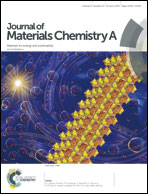Atomic-layer-deposited AZO outperforms ITO in high-efficiency polymer solar cells†
Abstract
Tin-doped indium oxide (ITO) transparent conducting electrodes are widely used across the display industry, and are currently the cornerstone of photovoltaic device developments, taking a substantial share in the manufacturing cost of large-area modules. However, cost and supply considerations are set to limit the extensive use of indium for optoelectronic device applications and, in turn, alternative transparent conducting oxide (TCO) materials are required. In this report, we show that aluminum-doped zinc oxide (AZO) thin films grown by atomic layer deposition (ALD) are sufficiently conductive and transparent to outperform ITO as the cathode in inverted polymer solar cells. Reference polymer solar cells made with atomic-layer-deposited AZO cathodes, PCE10 as the polymer donor and PC71BM as the fullerene acceptor (model systems), reach power conversion efficiencies of ca. 10% (compared to ca. 9% with ITO-coated glass), without compromising other figures of merit. These ALD-grown AZO electrodes are promising for a wide range of optoelectronic device applications relying on TCOs.



 Please wait while we load your content...
Please wait while we load your content...